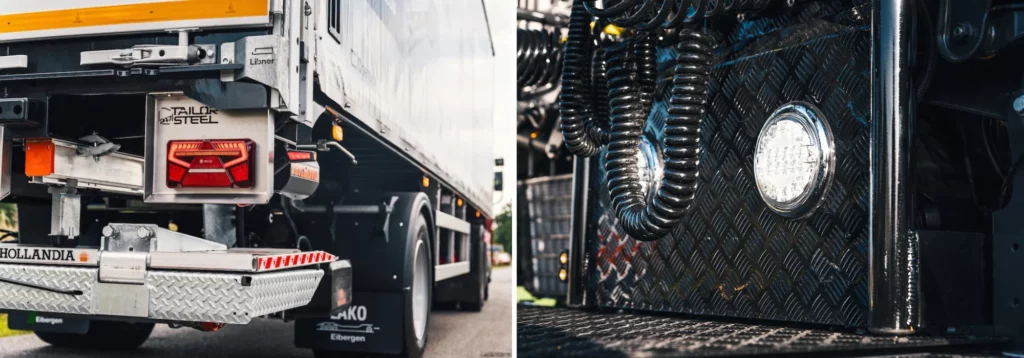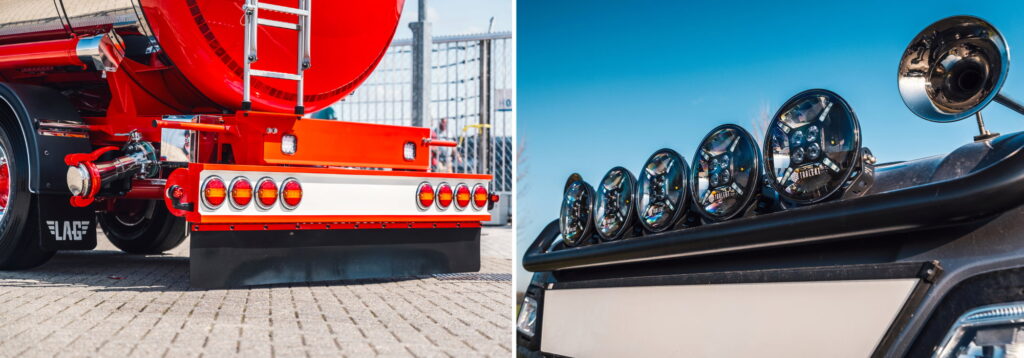In this blog you will learn:
- How the regulations for truck and semi-trailer lighting are structured. And which rules apply to light and heavy vehicles.
- You will also learn about European legislation and national exceptions in key countries such as the Netherlands, Germany, Italy, France, and the United Kingdom.

Lighting regulations for light commercial vehicles and small trucks (N1 vehicles)
Vehicles in the N1 category have a maximum allowed weight of 3.5 tons. These are usually light commercial vehicles and small trucks. Certain lighting elements are mandatory for these vehicles to ensure visibility and enable safe road use. Below are the main lighting requirements for this category.
| Lighting type | Quantity | Placement | Specific requirements |
|---|---|---|---|
| Head light | 2 | Minimum 500 mm from the ground | High and low beam required |
| Rear lights | 2 | On both sides at the rear | |
| Brake lights | 2 | On both sides at the rear | |
| Direction indicators | 4 | Front and rear | |
| Daytime running lights | 2 | Front | Mandatory for all newly registered trucks and buses in the EU since 2023. Trailers and semi-trailers remain exempt. |
| Reverse lighting | 1-2 | 1 reverse light is required for vehicles shorter than 6 meters. For vehicles longer than 6 meters, 2 reverse lights are required. | |
| Reflectors | 2 | Rear | Red reflectors, mandatory for all vehicles |
Europe has established its standards for lighting in the ECE regulations. These are followed by the 56 member states of the UNE.
- Contour markings: Mandatory for long vehicles (more than 6 meters), such as N3 and O4 vehicles. These markings provide extra visibility in the dark.

Lighting regulations for medium-duty trucks (N2 vehicles)
Vehicles in the N2 category weigh between 3.5 and 12 tons. These are medium-duty trucks that require additional lighting due to their size and weight. In particular, side marker lights are important for this category, especially for vehicles longer than 6 meters.
| Lighting type | Quantity | Placement | Specific requirements |
|---|---|---|---|
| Head light | 2 | Minimum 500 mm from the ground | High and low beam required |
| Rear lights | 2 | On both sides at the rear | |
| Brake lights | 2 | On both sides at the rear | |
| Direction indicators | 4 | Front and rear | |
| Daytime running lights | 2 | Front | Mandatory for all newly registered trucks and buses in the EU since 2023. Trailers and semi-trailers remain exempt. |
| Reverse lighting | 2 | Rear | Mandatory when reversing |
| Fog lights | 2 | Rear | Mandatory in poor weather conditions |
| Side marker lights | Min. 2 | Side, placed every 3 meters on vehicles >6m | Mandatory for vehicles longer than 6m |
| Reflectors | Min. 2 | Rear and side | Mandatory |
Lighting regulations for heavy-duty trucks (N3 vehicles)
Vehicles in the N3 category are heavy trucks with a weight of more than 12 tons. Stricter lighting regulations apply to this category, especially for side and contour marker lights, to increase the vehicle's visibility, especially in the dark and in poor weather conditions.
| Lighting type | Quantity | Placement | Specific requirements |
|---|---|---|---|
| Head light | 2 | Minimum 500 mm from the ground | High and low beam required |
| Rear lights | 2 | On both sides at the rear | |
| Brake lights | 2 | On both sides at the rear | |
| Direction indicators | 4 | Front and rear | |
| Daytime running lights | 2 | Front | Mandatory for all newly registered trucks and buses in the EU since 2023. Trailers and semi-trailers remain exempt. |
| Reverse lighting | 2 | Rear | Mandatory when reversing |
| Fog lights | 2 | Rear | Mandatory in poor weather conditions |
| Side marker lights | Min. 2 | Side, placed every 3 meters on vehicles >6m | Mandatory for vehicles longer than 6m |
| Contour marker lights | Min. 2 | Side, around the contour of the vehicle | Mandatory for vehicles over 2.1 meters wide |
| Reflectors | Min. 2 | Rear and side | Mandatory |
Lighting regulations for light trailers and semi-trailers (O1 vehicles)
The O1 category includes light trailers and semi-trailers up to 0.75 tons. Because these vehicles are small and light, less strict lighting regulations apply compared to heavier semi-trailers. However, reflectors and basic lighting are still mandatory to ensure visibility for other road users.
| Lighting type | Quantity | Placement | Specific requirements |
|---|---|---|---|
| Rear lights | 2 | On both sides at the rear | |
| Brake lights | 2 | On both sides at the rear | |
| Direction indicators | 2 | Rear | |
| Reflectors | Min. 2 | Rear | Red reflectors, mandatory |
Lighting regulations for medium-weight trailers and semi-trailers (O2 vehicles)
The O2 category includes semi-trailers and trailers with a weight between 0.75 and 3.5 tons. These vehicles are heavier and larger than O1 vehicles, so additional lighting, such as fog lights, is mandatory to ensure visibility.
| Lighting type | Quantity | Placement | Specific requirements |
|---|---|---|---|
| Rear lights | 2 | On both sides at the rear | |
| Brake lights | 2 | On both sides at the rear | |
| Direction indicators | 2 | Rear | |
| Fog lights | 2 | Rear | Mandatory in poor weather conditions |
| Reflectors | Min. 2 | Rear and side | Mandatory |
Lighting regulations for heavy trailers and semi-trailers (O3 vehicles)
The O3 category includes semi-trailers and trailers weighing between 3.5 and 10 tons. For this category, in addition to standard taillights, reversing lights and side marker lights are mandatory. This improves the visibility of the vehicle, especially when maneuvering or driving in the dark.
| Lighting type | Quantity | Placement | Specific requirements |
|---|---|---|---|
| Rear lights | 2 | On both sides at the rear | |
| Brake lights | 2 | On both sides at the rear | |
| Direction indicators | 2 | Rear | |
| Reverse lighting | 2 | Rear | Mandatory when reversing |
| Side marker lights | Min. 2 | Side, placed every 3 meters | Mandatory for vehicles longer than 6m |
| Reflectors | Min. 2 | Rear and side | Mandatory |
Flashing side lighting mandatory for O3 and O4 semi-trailers
From 1 January 2025, new semi-trailers (O4) and heavy trailers (O3) must be equipped with side lighting that flashes synchronously with the direction indicators. This requirement stems from UNECE regulation R48 and is being introduced to improve the side visibility of vehicles.
This may be via flashing side marker lights or a separate side direction indicator.
The rule applies only to vehicles newly put into service from 2025 onwards. Current vehicles will continue to be allowed unchanged.
Lighting regulations for heavy semi-trailers and trailers (O4 vehicles)
Vehicles in the O4 category are heavy trailers with a weight of more than 10 tons. Due to their size and weight, these vehicles are required to have additional lighting and contour markings to indicate their dimensions, especially when driving in the dark or in poor weather conditions.
| Lighting type | Quantity | Placement | Specific requirements |
|---|---|---|---|
| Rear lights | 2 | On both sides at the rear | |
| Brake lights | 2 | On both sides at the rear | |
| Direction indicators | 2 | Rear | |
| Reverse lighting | 2 | Rear | Mandatory when reversing |
| Side marker lights | Min. 2 | Side, placed every 3 meters | Mandatory for vehicles longer than 6m |
| Contour marker lights | Min. 2 | Side and rear, around the contour of the vehicle | Mandatory for vehicles over 2.1 meters wide |
| Reflectors | Min. 2 | Rear and side | Mandatory |
The applicable ECE regulations
For the installation and use of vehicle lighting in Europe, various ECE regulations apply. Here are the key ones you need to know:
- Installation of vehicle lighting, such as the placement, height, and distance of headlights, taillights, and indicators – ECE R48
- Regulations for indicators – ECE R6
- Requirements for taillights and brake lights – ECE R7
- Side marker lights for long vehicles – ECE R91
- Side marker lights voor lange voertuigen – ECE R91
- Daytime Running Lights (DRL) – ECE R87
Requirements for side marker lights on trucks
Here are the main requirements according to European regulations (ECE R91):
- Obligation: Side marker lights are mandatory for trucks longer than 6 meters.
- Number: At least 2 side marker lights per side.
- Placement: The lights must be placed along the side of the vehicle, with a maximum distance of 3 meters between each light.
- Light color: Side marker lights must be amber in color.
- ECE regulations: The technical requirements for side marker lights are defined in ECE R91. This includes aspects such as light intensity, reflective capacity, and proper placement.
Volgens de ECE R48-regelgeving moeten zijmarkeringslichten correct worden geplaatst. De afstand tussen de zijmarkeringslichten mag niet te groot zijn om ervoor te zorgen dat de truck of oplegger goed zichtbaar is, vooral in het donker of bij slecht weer.
Long and Heavy Vehicles (LHVs)
For Long and Heavy Vehicles (LHVs), which are longer than the standard 18.75 meters and weigh more than 60 tons, additional lighting requirements apply. LHVs must be equipped with:
- Side marker lights along the entire length of the vehicle.
- Side marker lights along the entire length of the vehicle.
What color of lighting is allowed?
Below is an overview of the key guidelines for the color of truck lighting:
Red light:
Only permitted at the rear of a vehicle. The use of red light at the front is not allowed to avoid confusion.
White light:
Mandatory for front vehicle lighting, such as high and low beams, position lights, and daytime running lights.
Engels (EN)
Amber light:
Permitted for turn signals and warning lights. This type of lighting is officially only allowed to warn or inform other road users.
National exceptions
Although European regulations are similar in many countries, there are some exceptions and additional requirements per country. Here are the main national differences:
Netherlands
In the Netherlands, the rules for vehicle lighting and warning lights are laid out in the Vehicle Regulations and additional guidelines for agricultural vehicles and other vehicles that move slowly on public roads.
- Fog lights: Rear fog lights are mandatory in cases of poor visibility (less than 50 meters) due to fog or heavy rain.
- Warning lights: Agricultural and forestry vehicles must be equipped with orange warning lights when driving on public roads.
- Width lighting: Vehicles wider than 2.10 meters must have width lighting.
Source: Rijksoverheid – Verlichtingseisen Voertuigen
Germany
In Germany, the rules for vehicle lighting fall under the Road Traffic Licensing Regulations (StVZO). This regulates the technical requirements for all vehicles
- Warning lighting: Additional warning lighting is mandatory for vehicles wider than 2.55 meters or longer than 18.75 meters.
- Side marker lights: Mandatory for vehicles longer than 6 meters, with a maximum distance of 3 meters between the lights.
- Contour marking: Long and wide vehicles must be equipped with white or yellow contour markings on the sides and red on the rear.
Source: Bundesministerium für Verkehr und digitale Infrastruktur (BMVI) – StVZO
Italy
In Italy, strict requirements apply to vehicles using tunnels, especially in mountainous areas. These rules are included in the Codice della Strada, the Italian traffic regulations.
- Warning lighting: In tunnels, additional warning lighting is required for vehicles with unusual dimensions.
- Reflectors: Vehicles must have additional reflectors on the front and rear to be visible in dark tunnels.
- Fog lights: The use of fog lights is mandatory in cases of poor visibility, such as in foggy tunnels or heavy rain.
Source: Ministero delle Infrastrutture e dei Trasporti – Codice della Strada
France
In France, the rules for daytime running lights are set out in the Code de la Route, the French traffic regulations. This legislation aligns with European standards and places additional emphasis on the use of daytime running lights (DRL).
- Daytime Running Lights (DRL): Mandatory for all trucks on all types of roads, whether inside or outside urban areas.
- Fog lights: Mandatory in poor weather conditions, especially in mountainous areas and tunnels.
Source: Service Public – Règles sur l’éclairage des véhicules
United Kingdom
Following Brexit, the United Kingdom largely continues to follow European regulations (ECE), but with some adjustments specific to agricultural vehicles and reflectors. The rules are set out in the Road Vehicles Lighting Regulations 1989.
- Reflectors on agricultural vehicles: Mandatory reflectors on agricultural vehicles, including orange and red reflectors on the rear and sides.
- Contour marking: For wider vehicles, additional contour markings are mandatory to indicate the outline of the vehicle.
Source: GOV.UK – Road Vehicles Lighting Regulations
Despite Brexit, the United Kingdom (UK) largely continues to adhere to the vehicle lighting standards of the UNECE (United Nations Economic Commission for Europe).
Do you want to be sure that your truck lighting complies with all regulations? Check out our extensive range of ECE-approved truck lighting.
Disclaimer:
At TRALERT®, we make every effort to keep the information in this article as accurate and up-to-date as possible, including regulations regarding vehicle lighting. However, legislation can change frequently, and while we strive to implement these updates promptly, certain updates or adjustments may not yet be reflected in this article. Therefore, we advise our readers always to check the current legislation with their local government agencies or regulatory bodies, especially concerning exceptions or specific national regulations. TRALERT
Always contact the competent authority in case of doubt to ensure that your vehicle complies with all legal requirements.

